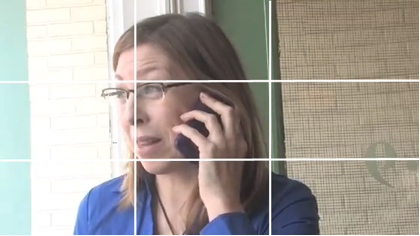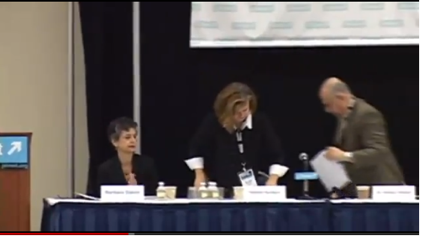Live from J Street, Part 2: Framing Tips for Conference Shooters and Webcasters
Jan Ozer passes on several key tips on framing panels and applying the rule of thirds (and when to break it) gleaned from his recent gig webcasting the national J Street conference on Israeli-Palestinian relations.
Like all video-related rules, it's better to know the rule and break it with intent than to not know it and break it accidentally. For example, in a recent video spoof that I shot, I placed my subject on the wrong saddle point to create a slight feeling of tension and to create diversity in my shots (Figure 3, below). However, I'd never use a shot like this in a seminar or business video.

Figure 3. Violating the rule of thirds to create a slight feeling of tension.
Going back to Figure 2, you'll note that the speaker's eyes are slightly above the top line, and that the J Street logo was shown fully with the bottom of the podium showing. However, the current videos on YouTube, from which I grabbed these streams, are not the videos that actually streamed live at the event. Rather, these were produced from the archived full DV file that we provided to the client after the event.
During the event itself, whether from the capture device or streaming service, the live video was cropped slightly on the top and bottom, so the rule of thirds positioning was closer and the bottom edge of the podium was cut off, leaving the logo shown in full. I was positioned right next to Zottig during the shoot, and he glanced frequently at the streaming feed to make sure that positioning was good and that nothing critical was cut off. However, Zottig seldom, if ever, made even slight adjustments to adjust his positioning, particularly to correct for rule of thirds.
That's because while few viewers will notice that rule of thirds is off, all viewers will notice if you make adjustments (even minute ones) in the middle of a shot to achieve perfect positioning. For this reason, it's best to get close to optimal positioning as quickly and smoothly as possible and then leave it alone. However, while I would not make minor adjustments on the fly to correct rule-of-thirds positioning, I would if critical branding or other noticeable edges were cut off.
Let's start codifying these into rules:
- Mind classic rule of thirds positioning, with the exceptions noted below.
- Avoid cutting off logos, branding, or other noticeable edges whenever possible.
- Get as close to optimal positioning as quickly and smoothly as possible, and then leave it alone unless critical branding or other noticeable edges are cut off.
- Observe both what's on your camera and what's in the streaming feed, since sometimes they'll be different.
Managing the Transition
Once a new speaker stepped to the podium, Zottig would quickly frame the speaker on his viewfinder and then check what was appearing in my streaming feed. Then he would typically sit down and watch the speaker, waiting for cues that he or she was about to finish.
Once the speaker finished, Zottig would follow the speaker back to his or her chair, and follow the new speaker up to the podium (Figure 4, below). This gave the remote viewer the same experience as the viewer in the room.

Figure 4. Managing the transition
Related Articles
In this final segment of this series on the JStreet Making History convention webcast, we'll examine one aspect of webcast production that too often gets ignored: monitoring and controlling audio volume, which becomes a complex issue as speakers change, audio techs and shooters adjust their own levels, and the webcaster is left to make sure the signal sent over the web remains audible and consistent.
HP's Z1 is the first all-in-one computer with workstation components and field serviceability. Here, encoding expert Jan Ozer takes a look at how this workstation-class portable PC fared in a live production and webcast environment, with testing emphasis in 3 areas: rendering, streaming encoding, and live encoding.
During a 3-day gig as webcaster for J Street's Making History conference on Israeli-Palestinian relations, Jan Ozer learned a lot about the challenges of streaming events where you don't control critical factors like the set background and lighting. In part 1 of 3 on this project, Jan details the planning process and streaming setup.